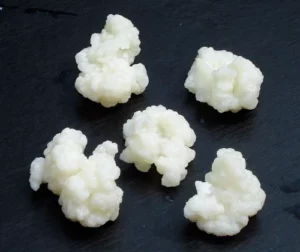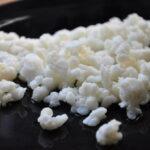
Milk Kefir is a fermented beverage that is cultured by using kefir grains. Kefir originates from the Caucasus Mountains, and was used to preserve milk before refrigeration existed. The kefir grains are made up of a combination of bacteria and yeasts that exist in a symbiotic relationship. Drinking or eating kefir food products has beneficial probiotic benefits for the body. Once you obtain kefir grains, you can ferment milk indefinitely as long as you continue to put the grains in fresh milk.
Description of Milk Kefir
Kefir grains are made up of a community of beneficial bacteria and yeasts that often include Lactococcus lactis subsp. Lactis, Lactococcus lactis subsp., Lactobacillus kefyr, Klyveromyces marxianus var. Marxianus, Saccaromyces unisporus, Diacetylactis, Leuconostoc mesenteroides subsp. Cremoris, and Lactobacillus kefyr. The grains are yellowish in color and resemble cauliflower in texture. During the fermentation process, kefir produces alcohol, acetic acid and lactic acid. The resulting fermented beverage thickens and has a slight sour taste. The drink also contains small amounts of alcohol and carbonation.
History
Traditionally, kefir was fermented in leather sacks that were hung on doors in the Caucasus Mountains of Eastern Europe. Whenever someone used the door, the kefir was shaken so that the grains could get to more fresh milk. Kefir grains can only be obtained from households that make the beverage, and can not be mass produced. The cultures are over 5000 years old. The people of the Caucasian Mountains regarded the grains as tribe and family wealth and passed them on from generation to generation.
Uses
The kefir culture can be used to make a variety of other probiotic foods beside just the kefir milk beverage. A soft cheese similar to cream cheese can be made by fermenting the milk for a longer period and then straining out the whey. The remaining whey left from making cheese can be used with salt and water to ferment and preserve vegetables from your garden. Butter and buttermilk can also be made with kefir cultures by blending and icing kefir cheese until the butter separates from the milk. Kefir grains can also be used to ferment alternative milks such as soy, coconut or nut milks.
Health Benefits
Kefir is similar to yogurt in that it contains probiotic bacteria that helps to improve digestion and the immune system. According to the Mayo Clinic, kefir may also help with diarrhea, prevent vaginal yeast and urinary tract infections, help irritable bowel syndrome and prevent colds and the flu. Typically, people with lactose intolerance are able to digest milk products once they have been fermented with kefir. Kefir may also help to regulate blood sugar and pressure in those who suffer from diabetes.
Safety
The beneficial bacteria and yeasts in kefir ward off many foodborne pathogens. However, it is still possible for it to become contaminated by E. coli, Salmonella, Listeria and Yersinia enterecolitica. It’s important to ferment milk with kefir properly. Pasteurized milk should be always be used for fermentation. Also, pregnant women, elderly and very young children should avoid kefir because they would be more susceptible to pathogens. Fermented foods can interact with metal, so it is important to use clean wood or plastic tools during the entire process. It’s also important to keep your kefir and kefir grains away from sunlight, and to continually add new fresh milk to your grains so they don’t die.
Keywords: milk kefir, make milk kefir, how to make milk kefir, about milk kefir, steps to make milk kefir, milk kefir fermentation
Check out Little Tree Food Forest for articles on food forests and homesteading.
Check out StoryScapes for articles on creative writing.








One thought on “About Milk Kefir”
Comments are closed.